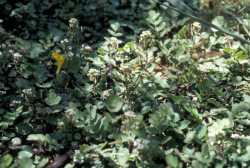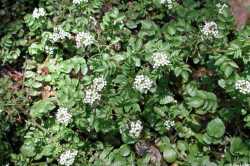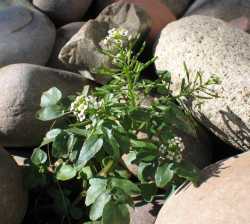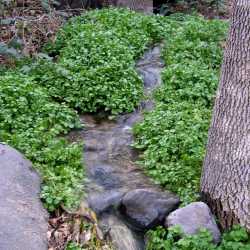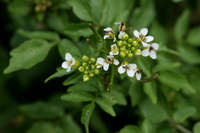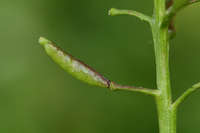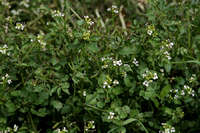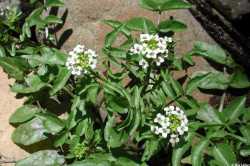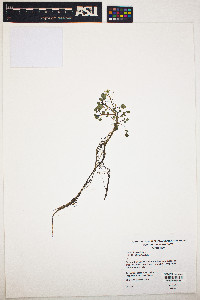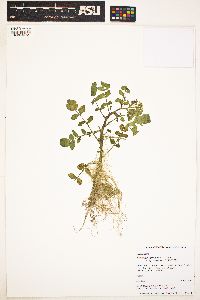|
Family: Brassicaceae
watercress
[ Nasturtium nasturtium-aquaticum (L.) H. Karst., moreNasturtium officinale var. siifolium (Rchb.) W.D.J. Koch, Rorippa nasturtium-aquaticum (L.) Hayek, Sisymbrium nasturtium-aquaticum L.] |
Plants glabrous throughout or sparsely pubescent. Stems 1-11 (-20) dm. Cauline leaves: petiole not winged, base auriculate; blade 3-9(-13)-foliolate, (1-) 2-15(-22) cm; lateral leaflets sessile or petiolulate, rachis not winged, blade smaller than terminal; terminal leaflet (or simple blade) suborbicular to ovate, or oblong to lanceolate, (0.4-)1-4(-5) cm × (3-)7-25(-40) mm, base obtuse, cuneate, or subcordate, margins entire or repand, apex obtuse. Fruiting pedicels divaricate or descending, straight or recurved, 5-17(-24) mm. Flowers: sepals 2-3.5 × 0.9-1.6 mm; petals white or pink, spatulate or obovate, 2.8-4.5(-6) × 1.5-2.5 mm, (base to 1 mm), apex rounded; filaments 2-3.5 mm; anthers 0.6-1 mm. Fruits (0.6-)1-1.8(-2.5) cm × (1.8-)2-2.5(-3) mm; ovules (28-)36-60 per ovary; style 0.5-1(-1.5) mm. Seeds biseriate, reddish brown, ovoid, (0.8-)0.9-1.1 (-1.3) × (0.6-)0.7-0.9(-1) mm, coarsely reticulate with 25-50(-60) areolae on each side. 2n = 32. Flowering Feb-Sep. Flowing streams, ditches, lake margins, swamps, marshes, seeps; 0-3000 m; introduced; Alta., B.C., Man., N.B., Nfld. and Labr. (Nfld.), N.S., Ont., P.E.I., Que.; Ala., Alaska, Ariz., Ark., Calif., Colo., Conn., Del., D.C., Fla., Ga., Idaho, Ill., Ind., Iowa, Kans., Ky., Maine, Md., Mass., Mich., Minn., Miss., Mo., Mont., Nebr., Nev., N.H., N.J., N.Mex., N.Y., N.C., N.Dak., Ohio, Okla., Oreg., Pa., R.I., S.C., S.Dak., Tenn., Tex., Utah, Vt., Va., Wash., W.Va., Wis., Wyo.; Europe; Asia; n Africa; introduced also elsewhere in the New World, tropical and s Africa, Australia. Perennial; stems submersed or partly floating, or prostrate on mud, freely rooting; lvs of 3-9 obtuse segments, the lateral ovate to rotund, the terminal much larger, usually rotund; fls 5 mm wide, the pet twice as long as the sep; mature pedicels divaricate, 8-15 mm; frs slender, 1-2.5 cm, the beak 1 mm; seeds coarsely reticulate; 2n=32, 48, 64. Native of Eurasia, now widely established in clear quiet water throughout the U.S. and s. Can. All summer. (Radicula n.; Sisymbrium n.; Nasturtium microphyllum; N. officinale) Some botanists now restrict the name R. nasturtium-aquaticum to the "diploid" race (2n=32), and call the tetraploids (2n=64) R. microphylla (Boenn.) Hyl., regarding the plants with 2n=48 as vegetatively reproducing hybrids. The two types differ as follows:
Gleason, Henry A. & Cronquist, Arthur J. 1991. Manual of vascular plants of northeastern United States and adjacent Canada. lxxv + 910 pp.
©The New York Botanical Garden. All rights reserved. Used by permission. Duration: Perennial Nativity: Non-Native Lifeform: Forb/Herb General: Perennial aquatic or semi-aquatic herb; succulent stems floating, creeping or ascending, rooting at the nodes, 10-80 cm or more long; glabrous. Leaves: Pinnately divided into ovate to orbicular segments, the terminal one the largest, 1-10 cm long, narrowly clasping at the base. Flowers: Racemes without bracts; pedicels spreading to ascending, 5-13 mm long; sepals 2-3 mm long, green or with white tips; petals white, 3-5 mm long, oblanceolate. Fruits: Siliques spreading or curved upward, 1-3 cm long, 2-3 mm wide; style about 1 mm long. Ecology: Found in water or very wet soil; 1,500-7,500 ft (460-2285 m); flowers April-August. Distribution: Introduced to all of N. America, found in every state in the US; south through MEX, C. America and S. America; throughout much of the rest of the world on every continent. Notes: Highly distinct and ubiquitous plant of wetlands; distinguished by the fact it is only in wet places; has creeping, highly branched stems which cover areas, root at nodes and float in water; pinnately compound leaves; inflorescences of white petals and elongated fruits. Greens have a spicy mustard taste. Ethnobotany: Havasupai used for food. Other tribes and cultures around the world eat as greens. Sold in some supermarkets. Etymology: Rorippa is an Anglo-Saxon work rorippen with an uncertain meaning, while nasturtium-aquaticum is from the Latin nasus tortus, a twisted nose. Synonyms: Rorippa nasturtium-aquaticum, Sisymbrium nasturtium-aquaticum, Nasturtium nasturtium-aquaticum Editor: SBuckley 2010, FSCoburn 2015 |


